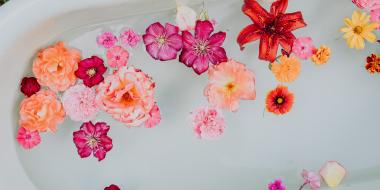For many of us, our monthly flow comes and goes each month without much pomp and circumstance. Unless we’re hoping to get pregnant or are intentionally keeping an eye on our body’s rhythms to avoid conceiving, our period can seem more like a monthly inconvenience than something magical, worthy of celebration. But periods are amazing! Not only are they an automated self-cleaning system, they also indicate our body’s potential to create life, and are an important barometer of our health.
The term menstruation itself comes from Latin and Greek and is closely tied to the words “month” and “moon.” The moon and our menses share a long history. In ancient times, periods were honoured and revered, recognizing the moon’s ability to regulate menstrual cycles and even improve fertility. Many North American Indigenous peoples treat “moon time” as a time of healthy cleansing and evidence of women’s spiritual power and special closeness with nature. Furthermore, Traditional Chinese Medicine believes the menstrual cycle is connected to the four seasons that move with the moon, granting our bodies a oneness with the universe.
Since we know that the moon plays a role in the ocean’s tides, and when one considers the way in which our cycle closely mimics the waxing and waning of the lunar cycle, it is understandable that we’re fascinated with the idea that it may influence our own bodies. There is a strong belief that you can “tune into” the moon and sync your cycle to it, and while evidence to support this is mostly anecdotal, following the moon’s movement over the months is a great way to get in touch with nature and your own natural rhythms—so go with the flow!
Cycle Stats
A typical cycle is 28 days (though in adult women, an “average” range is from 21 to 35 days, and even more broadly, “normal” is what’s normal for you) and begins with the first day of menstrual bleed. Days 1 to 14 is the follicular phase when estrogen rises and peaks and a follicle matures. Days 15 to 28 is the luteal phase when a rise in progesterone causes the lining of the uterus to thicken. This is when a fertilized egg would have the opportunity to attach to the uterine lining and grow. If there is no implantation, the lining will shed as a menstrual flow.
Let the Moon Be Your Guide
Irregular periods, heavy flow, or cramping may all be signs that your hormones are out of balance. Hormonal imbalances are quite common and are often due to a myriad of reasons including discontinuing oral contraceptives, miscarriage, stress, or because of hormonal conditions such as Polycystic Ovarian Syndrome, endometriosis, perimenopause, and thyroid issues. It’s a must to get a full work-up from your healthcare provider to figure out what’s going on, but adding the complementary practice of seed cycling according to the moon’s wax and wane phases if you’re irregular or aren’t menstruating may also lend a helping hand in getting you back on track when your cycle is out of whack! You can also use seed cycling if you’re regular but your hormones are giving you period grief.
Seed cycling is a tasty practice that promotes the production of certain hormones that might be lacking or are out of balance during a specific phase of your menstrual cycle. Readily found in stores (and probably already in your pantry!) the following seeds contain amazing attributes which help produce estrogen and progesterone, and are perfectly suited to the two phases of your cycle!
Tips and Tricks
Begin each two-week phase by grinding one cup of each seed together and storing them in a covered glass jar in the fridge. That way, they’ll always be ready to go! Add them to your salad, mix into yogurt, blend into a smoothie, or sprinkle them onto oatmeal.
New Moon to Full Moon = Follicular Phase
- Follicular Phase Friends: include flax seeds and pumpkin seeds, both of which support estrogen production to help produce a mature follicle, and prepare the uterine lining for implantation.
- Feed your phase: 2 Tbsp each of ground flax and pumpkin seeds daily.
Full Moon to New Moon = Luteal Phase
- Luteal Phase Allies: include sesame and sunflower seeds, both of which support progesterone production and provide essential hormone nutrients like zinc and vitamin E.
- Feed your phase: 2 Tbsp each of ground sesame and sunflower seeds daily.
Follow the moon until you begin regularly menstruating (this may take at least three cycles to be successful). Once that happens, day one of the seed cycle protocol will then be the first day of your menstrual flow.
Though not entirely scientific, using the rhythm of the moon as a tool to help you get in a good menstrual groove is a traditional technique that’s easy to execute and a nice way to feel a connection to nature. As nature intended, our bodies are marvelous machines with modes and moods that respond well to gentle tending and wholesome nourishing. Let yours, like the moon, be an object of celebration.
You may also enjoy: Seed Cycling: a Natural Path to Hormone Balance, The Phases of the Menstrual Cycle Explained Simply, and Understanding Your Period: The Menstrual Cycle.






